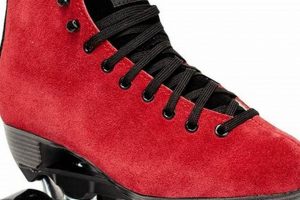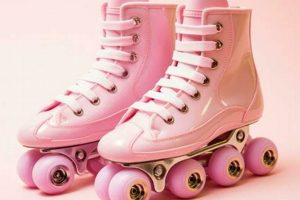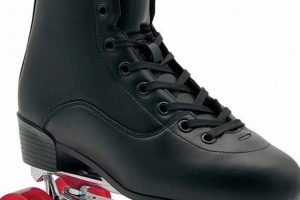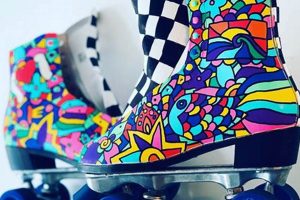Footwear integrating the rolling functionality of skates with the design of conventional athletic shoes allows for ambulation and recreational skating. These hybrid devices offer a unique blend of mobility and convenience, enabling users to transition seamlessly between walking and rolling. An example would be a shoe with retractable wheels integrated into the sole.
This innovation presents advantages in personal transportation and fitness. Historically, the desire for increased personal mobility has driven innovation in wheeled footwear. The combination of a familiar shoe form factor with skating capabilities provides ease of use and accessibility for a wider audience. This promotes physical activity and offers a practical solution for short-distance travel.
The following sections will delve into the specific design considerations, technological advancements, and performance characteristics of these dual-purpose shoes, exploring their impact on recreation and transportation.
Considerations for Wheeled Footwear Selection
Selecting appropriate wheeled footwear requires careful evaluation to ensure both safety and performance. The following guidelines address critical aspects of the selection process.
Tip 1: Assess Intended Use: Determine the primary application. Casual recreational use requires different features than specialized dance or trick skating. The intended environment will dictate necessary durability and wheel characteristics.
Tip 2: Evaluate Wheel Material and Hardness: Wheel material (e.g., polyurethane) impacts grip and wear. Durometer, measured on the A scale, indicates hardness; softer wheels offer greater grip, while harder wheels provide greater speed and durability. Select a durometer appropriate for the skating surface.
Tip 3: Examine Bearing Quality: Bearings influence rolling efficiency. ABEC ratings indicate precision; higher ABEC ratings generally correlate with smoother, faster rolling. Consider stainless steel bearings for wet environments.
Tip 4: Confirm Boot Support and Fit: Adequate ankle support minimizes injury risk. Ensure a snug, comfortable fit that allows for freedom of movement without excessive slippage. Consider heat-moldable boots for a customized fit.
Tip 5: Inspect Braking Mechanism Functionality: Reliable braking is essential for safety. Verify the braking mechanism (toe stop or heel brake) is functional and responsive. Practice braking techniques in a controlled environment.
Tip 6: Prioritize Safety Equipment: Protective gear, including a helmet, wrist guards, elbow pads, and knee pads, is paramount. Ensure equipment fits properly and meets safety standards.
Tip 7: Maintenance and Inspection: Regularly inspect wheels, bearings, and brakes for wear and damage. Clean bearings and replace worn components to maintain optimal performance and safety.
Careful consideration of these aspects will facilitate selection of wheeled footwear that meets individual needs and minimizes risk.
The subsequent section will explore the technological advancements driving the evolution of this type of footwear.
1. Retractability Mechanism
The retractability mechanism is a core component of the footwear category blending roller skates and sneakers. This mechanism dictates the user’s ability to transition between a walking gait and a rolling motion. Its functionality directly impacts the overall practicality and user experience. The mechanism’s effectiveness, including its reliability and ease of use, directly affects the appeal of this type of footwear.
Several designs exist, ranging from manually operated levers to spring-loaded releases. The choice of design impacts durability, ease of deployment, and potential for malfunction. A robust and intuitive mechanism increases the likelihood of user adoption. For example, a mechanism that frequently jams or requires excessive force to operate will detract from the product’s usability, reducing its appeal despite other potentially positive features. Conversely, a well-designed system contributes directly to safety by allowing quick transition to a walking mode in hazardous situations.
In summary, the retractability mechanism represents a critical engineering challenge and a key determinant of product success within the hybrid roller skate sneaker market. Its design and implementation impact user convenience, safety, and the overall viability of this footwear concept. Future advancements in this area will likely focus on increased durability, simplified operation, and improved integration with the shoe’s overall aesthetic.
2. Wheel Durometer and Hybrid Roller Skates Sneakers
Wheel durometer, measured on the A scale, specifies the hardness of the wheel and is a crucial performance factor in footwear combining roller skates and sneakers. The durometer rating directly affects the wheel’s grip, roll speed, and wear resistance, thus significantly influencing the user experience. A lower durometer rating indicates a softer wheel, offering increased grip on surfaces but potentially sacrificing speed and longevity. Conversely, a higher durometer rating signifies a harder wheel, promoting faster rolling speeds and increased resistance to wear but potentially reducing grip, particularly on slick surfaces. The selection of wheel durometer must align with the intended application and skating environment.
For example, a user primarily skating indoors on smooth, polished surfaces might benefit from a harder wheel with a durometer rating of 88A or higher to maximize speed and minimize wear. Conversely, someone primarily skating outdoors on rough asphalt or concrete might prefer a softer wheel with a durometer rating of 78A to 82A to enhance grip and absorb vibrations. In designs where the skate wheels are retractable, the durometer choice becomes more critical, as it must balance performance in skating mode with considerations for walking comfort when the wheels are retracted. A very hard wheel may be uncomfortable to walk on when retracted, while a very soft wheel may wear down quickly from contact with the ground even when retracted.
In conclusion, wheel durometer represents a critical engineering consideration in the design and selection of footwear that combine the functionality of roller skates and sneakers. The optimal durometer balances the competing needs of grip, speed, durability, and walking comfort. Understanding the relationship between durometer and performance enables informed purchasing decisions and promotes a safer, more enjoyable skating experience. Further research into advanced wheel materials and durometer ratings tailored to specific hybrid designs will continue to refine the performance characteristics of this innovative footwear category.
3. Bearing Precision (ABEC)
Bearing precision, quantified by the Annular Bearing Engineering Committee (ABEC) rating system, represents a critical determinant of performance in footwear combining roller skates and sneakers. The ABEC rating directly influences rolling efficiency, speed, and durability, thereby impacting the overall user experience. Higher ABEC ratings generally indicate tighter tolerances and smoother operation, translating to improved rolling performance. The selection of an appropriate ABEC rating is therefore paramount in the design and selection of hybrid roller skate sneakers.
- Rolling Efficiency and Speed
Bearings with higher ABEC ratings exhibit reduced friction due to their tighter manufacturing tolerances. This translates to increased rolling efficiency, allowing the wheels to spin more freely and for longer durations with each push. In roller skates sneakers, this improved efficiency can result in a noticeable increase in speed and a reduction in the effort required for propulsion. Conversely, lower ABEC rated bearings may exhibit increased friction, requiring more effort to maintain speed and potentially limiting overall performance.
- Durability and Longevity
Tighter tolerances and higher quality materials, often associated with higher ABEC ratings, can contribute to increased bearing durability. Bearings in roller skates sneakers are subjected to significant stress, including impacts from uneven surfaces and constant rotational forces. Bearings with higher ABEC ratings are generally better equipped to withstand these stresses, maintaining their performance characteristics over a longer period. Lower-rated bearings may be more susceptible to wear and damage, requiring more frequent replacement.
- Vibration and Noise Reduction
Higher precision bearings tend to operate more smoothly and quietly than lower precision bearings. This is due to the reduced internal friction and more consistent contact between the bearing components. In roller skates sneakers, smoother, quieter operation can contribute to a more comfortable and enjoyable skating experience, particularly on rough or uneven surfaces. Conversely, lower-rated bearings may generate more vibration and noise during operation, potentially detracting from the user experience.
- Cost Considerations
ABEC ratings correlate with manufacturing cost, meaning higher precision bearings generally command a higher price. While higher ABEC rated bearings offer performance advantages, the incremental benefits may not justify the additional cost for all users. For casual recreational use, mid-range ABEC rated bearings may offer a reasonable balance of performance and cost. However, for more demanding applications, such as competitive skating or trick skating, the investment in higher ABEC rated bearings may be warranted to maximize performance and durability.
In summary, the ABEC rating of bearings represents a crucial specification in footwear combining roller skates and sneakers. While higher ABEC ratings offer potential improvements in rolling efficiency, durability, and smoothness, the optimal choice depends on the intended application and budget constraints. Understanding the relationship between ABEC rating and performance enables informed purchasing decisions and promotes a safer, more enjoyable skating experience. Continued innovation in bearing design and manufacturing may further refine the performance characteristics of hybrid roller skate sneakers.
4. Ankle Support
Adequate ankle support is a paramount safety and performance consideration in the design and use of roller skates sneakers. The inherent instability associated with wheeled footwear necessitates robust ankle support to mitigate injury risk and enhance control. Insufficient ankle support can lead to sprains, strains, and fractures, while proper support promotes stability and facilitates efficient energy transfer during skating.
- Lateral Stability Enhancement
Lateral stability refers to the ability to resist movement from side to side. Roller skates sneakers, due to their elevated platform and rolling wheels, inherently compromise lateral stability. Effective ankle support counteracts this instability by providing a rigid or semi-rigid structure that limits excessive pronation (inward rolling) and supination (outward rolling) of the ankle joint. For example, a high-cut boot design with reinforced ankle cuffs can significantly improve lateral stability, reducing the likelihood of ankle sprains during sudden turns or impacts.
- Injury Prevention Mechanisms
Ankle support mechanisms, such as padded liners and adjustable straps, function to cushion and stabilize the ankle joint, thereby reducing the risk of injury. These mechanisms work by distributing impact forces and limiting the range of motion within the ankle joint. A well-designed ankle support system will minimize the potential for hyperextension, hyperflexion, and excessive twisting, all of which can lead to ligament damage. For instance, integrated heel counters and adjustable instep straps contribute to a secure and customized fit, preventing ankle displacement during activity.
- Control and Maneuverability Improvement
Ankle support directly influences the skater’s ability to control and maneuver the footwear. A stable ankle joint allows for more precise and efficient transfer of force from the skater’s body to the wheels, enabling sharper turns, faster acceleration, and improved overall control. Conversely, weak or inadequate ankle support can result in wobbly movements and reduced responsiveness. Consider the difference between a figure skater’s stiff, supportive boot and a recreational skater’s soft, flexible shoe; the former allows for intricate maneuvers, while the latter prioritizes comfort over precision.
- Fatigue Reduction and Comfort Augmentation
Proper ankle support can contribute to reduced fatigue and increased comfort during prolonged skating sessions. By providing stability and reducing the strain on the ankle muscles and ligaments, a supportive ankle system can minimize muscle fatigue and prevent discomfort. Furthermore, padded liners and breathable materials can enhance comfort by wicking away moisture and reducing friction. A comfortable and supportive fit encourages longer skating sessions and promotes a more positive user experience. Without, fatigue will rapidly increase potentially leading to further injury.
The interplay between these facets highlights the critical importance of ankle support in roller skates sneakers. Effective ankle support mechanisms are not merely an optional feature but a fundamental requirement for safety, performance, and user satisfaction. As technology evolves, improvements in materials and design will further enhance the efficacy of ankle support systems in this innovative footwear category, pushing the boundaries of recreational and transportation applications.
5. Braking System
A functional braking system is an indispensable component of footwear that combines roller skates and sneakers. This system provides the necessary means for controlled deceleration and stopping, directly impacting user safety and maneuverability. The absence or inadequacy of a braking system elevates the risk of collisions, falls, and subsequent injuries. These systems are typically integrated as a heel brake, toe stop, or, less commonly, utilize electronic braking mechanisms. The selection and proper functioning of the braking system determine the degree of control users possess over their motion, particularly at varying speeds and on different surfaces.
The design and implementation of the braking system must consider several factors, including the type of skating activity, the skill level of the user, and the environment in which the footwear is used. A recreational skater on a flat, smooth surface may find a simple heel brake adequate, while an aggressive skater performing complex maneuvers may require a more responsive and robust system. The effectiveness of the braking system is also influenced by factors such as wheel durometer, surface friction, and the user’s weight and technique. Regular inspection and maintenance of the braking system are crucial to ensure its continued functionality and reliability. Failure to maintain the braking system can compromise its effectiveness, increasing the risk of accidents.
In conclusion, the braking system represents a fundamental safety feature of roller skates sneakers. Its design, implementation, and maintenance directly impact user safety and control. Ongoing advancements in braking technology, coupled with user education on proper braking techniques, are essential to minimizing the risk of accidents and promoting a safe and enjoyable skating experience. Understanding the principles and practical implications of effective braking is crucial for both manufacturers and users of this hybrid footwear.
Frequently Asked Questions About Roller Skates Sneakers
The following section addresses common inquiries regarding footwear incorporating both roller skates and sneaker elements, providing factual information to clarify typical concerns.
Question 1: What are the primary safety considerations when using roller skates sneakers?
The use of appropriate safety equipment, including helmets, wrist guards, elbow pads, and knee pads, is paramount. Ensure a secure fit and familiarize oneself with braking techniques before use. Regular inspection of wheels, bearings, and braking mechanisms is also essential.
Question 2: How does wheel durometer affect the performance of roller skates sneakers?
Wheel durometer, measured on the A scale, indicates wheel hardness. Lower durometer values signify softer wheels, offering enhanced grip. Higher durometer values represent harder wheels, providing increased speed and durability. Wheel selection should align with the intended skating surface and user preferences.
Question 3: What is the significance of ABEC ratings in roller skates sneakers?
ABEC ratings denote the precision of the bearings. Higher ABEC ratings generally correspond to tighter tolerances and smoother rolling characteristics. While higher ABEC ratings often improve performance, the incremental benefit may not justify the increased cost for all users.
Question 4: How important is ankle support in roller skates sneakers?
Adequate ankle support is crucial for stability and injury prevention. A secure and supportive fit minimizes the risk of ankle sprains and strains. High-cut boot designs and reinforced ankle cuffs contribute to enhanced lateral stability.
Question 5: What type of maintenance is required for roller skates sneakers?
Regular maintenance includes cleaning bearings, inspecting wheels for wear, and ensuring the proper functionality of the braking mechanism. Lubrication of bearings may be necessary to maintain optimal performance. Damaged components should be replaced promptly.
Question 6: Are roller skates sneakers suitable for all ages and skill levels?
Roller skates sneakers may be suitable for a range of ages and skill levels, provided users exercise caution and adhere to safety guidelines. Novice users should begin in controlled environments under supervision. Individuals with pre-existing medical conditions should consult with a healthcare professional before use.
In summary, responsible usage of roller skates sneakers hinges on the understanding of safety precautions, performance characteristics, and maintenance requirements.
The following section will present concluding remarks.
Conclusion
The preceding analysis has presented a detailed overview of roller skates sneakers, examining critical aspects from design considerations to performance characteristics. The integration of rolling functionality into conventional footwear presents unique challenges and opportunities. Wheel durometer, bearing precision, ankle support, and braking systems collectively define the operational efficacy and user safety of these devices.
Continued technological advancements and responsible user practices are crucial for the sustained development and acceptance of roller skates sneakers. Further research into advanced materials, improved safety mechanisms, and refined ergonomic designs is warranted to maximize the potential benefits of this hybrid footwear category. Prudent adoption and adherence to safety guidelines are essential to mitigate inherent risks and promote a positive user experience. The ongoing evaluation of performance parameters and the dissemination of factual information remain paramount to ensuring the responsible application of this innovative technology.







